Saffron Risotto Milanese: The Irresistible Color and Unforgettable Taste (VIDEO)

Learn the secrets to making the perfect saffron risotto milanese – from the rich, golden color to the irresistible taste, this dish is sure to impress! I’m sharing my favorite tips and techniques to make the most delicious risotto using saffron. Give it a try and elevate your cooking game with this classic Italian dish!
What is Risotto alla Milanese
The traditional recipe for Milanese saffron risotto consists of rice cooked slowly in a flavorful meat broth. Saffron threads are added during the cooking process, infusing the dish with their distinct aroma and golden hue. Butter, onion, white wine, and Parmesan cheese are also key ingredients that contribute to the creamy and savory nature of the risotto.
Today, Milanese saffron risotto remains a beloved and iconic dish in Italian cuisine. It is often served as a main course or as a side dish accompanying various meat or fish dishes. Its rich history and unique flavors continue to captivate food enthusiasts around the world, making it a timeless culinary delight.
Milanese Risotto History
Milanese saffron risotto, also known as “Risotto alla Milanese,” is a classic Italian dish with a rich history. The origins of Milanese saffron risotto can be traced back to the city of Milan in Lombardy, Italy. It is believed to have been created in the 16th century, during the Renaissance period. The dish is characterized by its vibrant yellow color, which is achieved by incorporating saffron threads into the rice.
Legend has it that a young apprentice was working on staining the glass windows of the Milanese cathedral, known as the Duomo di Milano. He accidentally spilled some saffron into the pot of rice being prepared for a wedding feast. Rather than discarding the rice, the chef decided to serve it, and the resulting saffron-infused risotto became a sensation.
Saffron, an expensive spice derived from the crocus flower, was a symbol of wealth and luxury. It was traditionally used to enhance the flavor and color of dishes served during important occasions. Milanese saffron risotto quickly gained popularity among the noble families of Milan and became a signature dish of the city.
Watch Milanese Risotto Video Recipe
Saffron Risotto and Milanese Risotto: the Differences?
Saffron Risotto is the basic version of Milanese Risotto. The rice can be the same, (Carnaroli and Arborio are most commonly used), but the rest of ingredients needed to complete the two recipes are not the same. The main difference in ingredients and the presence, in Milanese Risotto, of meat and bone marrow.
Indeed, if you want to cook a dish of Risotto Milanese, you must use strictly meat broth, while for Saffron Risotto you can also opt for a lighter vegetable broth.
Then, there is the Ossobuco. This cut of meat is cooked separately and then served with Risotto Milanese, which must cook together with bone marrow, a fundamental ingredient to make a true Risotto Alla Milanese. Obviously, there is no trace of Ossobuco or bone marrow in Saffron Risotto.
The two recipes are also reinterpreted, and it is not uncommon to see additions to the dishes. For example, ingredients such as mushrooms or watercress can be added, as well as flavorful cheeses such as Gorgonzola to make it creamier.
Risotto alla Milanese Ingredients
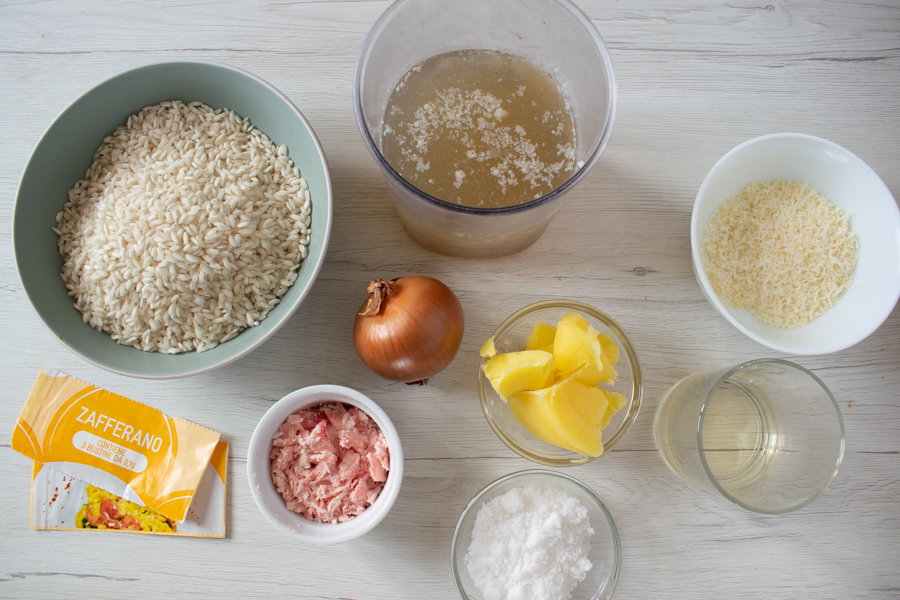
To prepare a delicious Milanese risotto, you will need the following ingredients:
- Arborio or Carnaroli Rice: These short-grain rice varieties are ideal for making risotto as they absorb liquid well and release starch, resulting in a creamy texture.
- Saffron: Saffron is the star ingredient in saffron Milanese risotto. It adds a distinct flavor, aroma, and vibrant yellow color to the dish. Use high-quality saffron threads for the best results.
- Bone marrow: The creamy consistency of bone marrow blends seamlessly with the risotto, contributing to its velvety texture. As the marrow melts during the cooking process, it releases its natural fats, which help create a luscious mouthfeel. Moreover, bone marrow is known for its intense, rich, and savory flavor. When added to the risotto, it infuses the dish with a luxurious and complex taste, adding depth to the overall flavor profile.
- Broth: Meat broth is typically used to cook the risotto. You can use homemade broth or store-bought options. The broth adds flavor and helps in cooking the rice.
- Onion: Finely chopped onion is used as a base for the risotto, providing a savory flavor.
- White Wine: A dry white wine, such as a Pinot Grigio or Chardonnay, is added to the risotto to deglaze the pan and enhance the overall flavor.
- Butter: Butter adds richness and a velvety texture to the risotto. It is typically added towards the end of cooking.
- Parmesan Cheese: Grated Parmesan cheese is stirred into the risotto, giving it a creamy and tangy flavor. Use freshly grated Parmesan for the best taste.
- Salt: Season the risotto with salt to taste, adjusting according to your preferences.
How to Make Risotto Milanese
Here are the easy steps to make a perfect Milanese Risotto.
Sauté the onion – First, peel and finely chop the onion. In a large skillet (where you will prepare the risotto), add 20 g of butter and bone marrow. Melt over medium heat, then add the onion and sauté for 1–2 minutes, until it begins to become translucent.
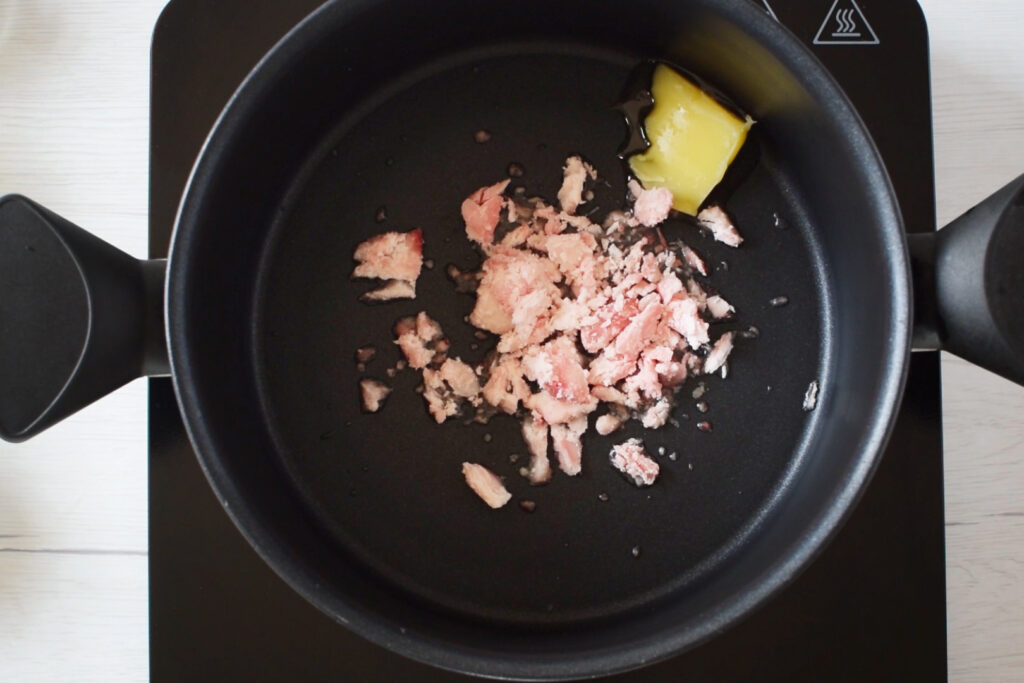
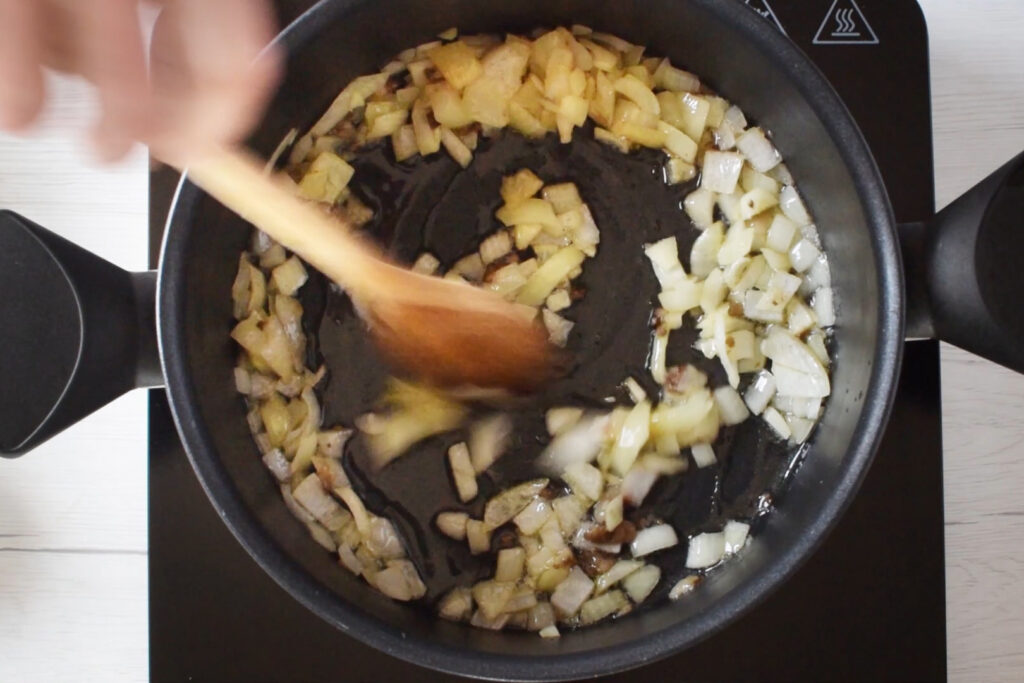
Toast the Rice – Add the rice. Toast the rice for half a minute over medium-high heat while constantly stirring. This step will allow you to obtain an al dente risotto with intact grains!
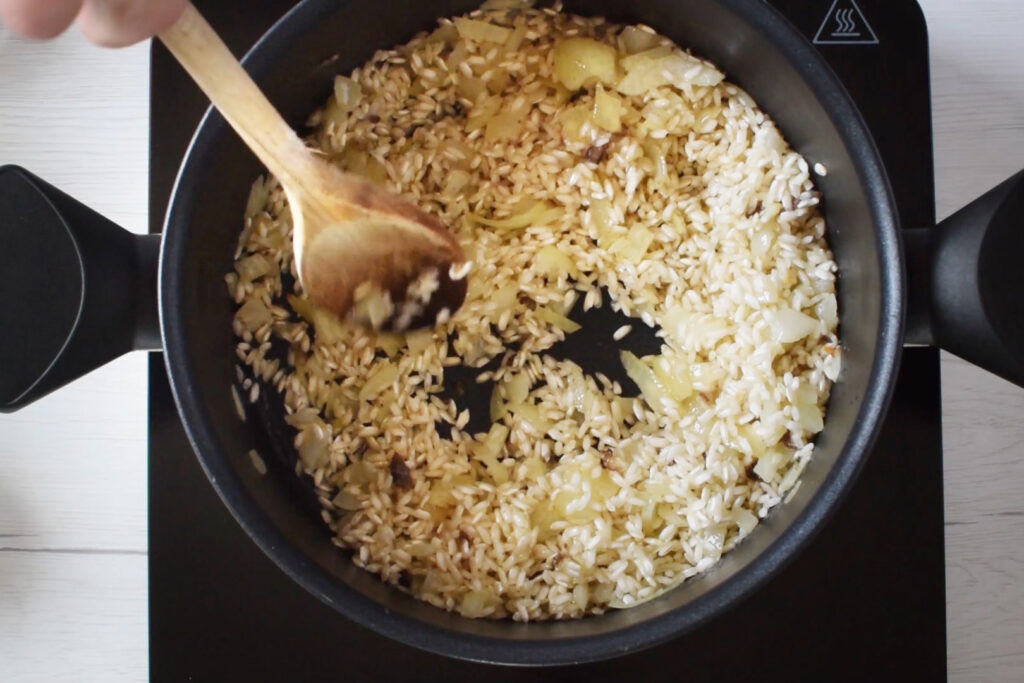
Add the Liquids – Add the white wine. Let it fully evaporate. Then lower the heat and begin adding the hot broth, one ladle at a time, stirring often and adding more broth each time the risotto is about to dry out! Be sure the broth is hot, otherwise everything will overcook.
Add the Saffron – Finally, when the rice is al dente, add the saffron threads (or if using pistils, add the 2 teaspoons of orange-colored filtered water you soaked the pistils in the night before). Stir very well over low heat. Season with salt. At this stage, the risotto should not be liquid, but cooked and dry.
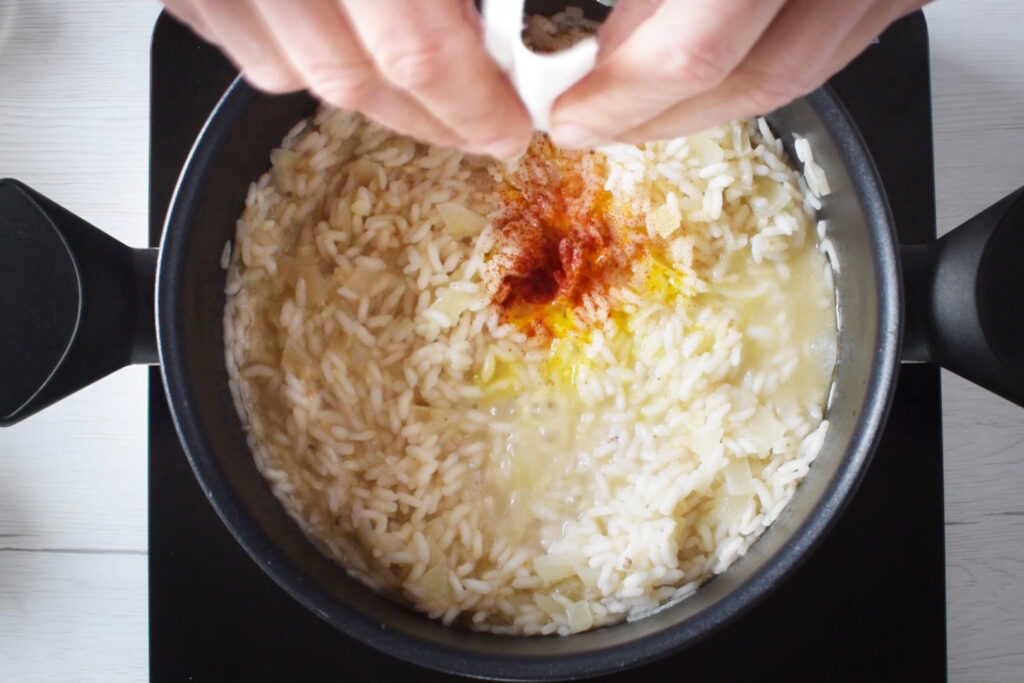
Make the Risotto creamy – Then add the remaining butter and grated Parmesan, stir with a spoon over off heat so that the saffron Milanese risotto becomes creamy! Add only 1 or 2 teaspoons of hot broth if the rice seems too dry. The final risotto should be soft and creamy.
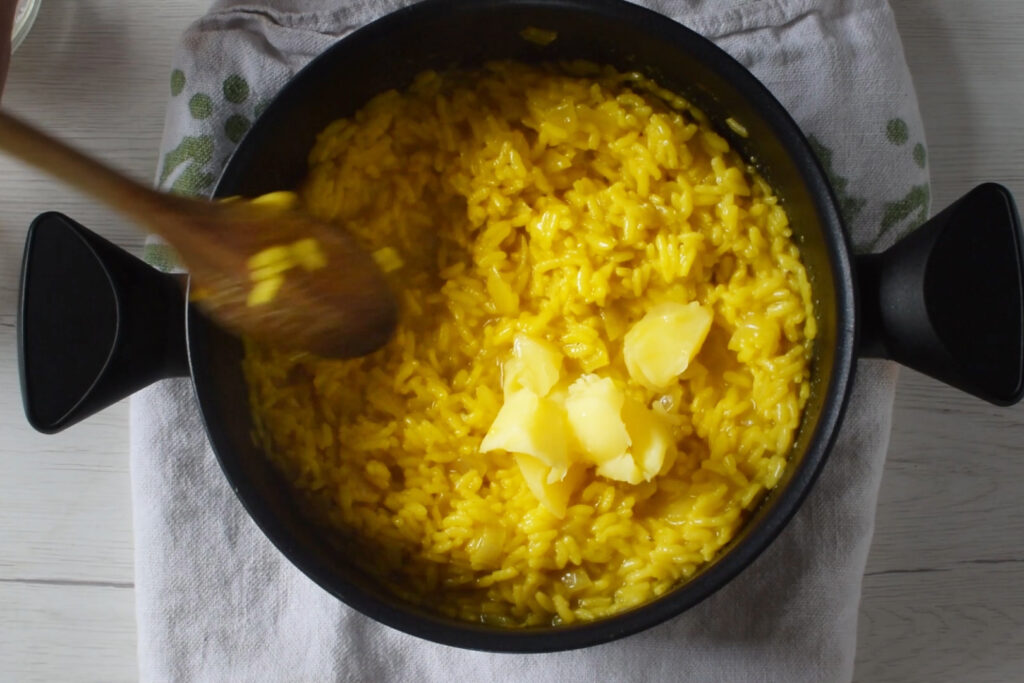
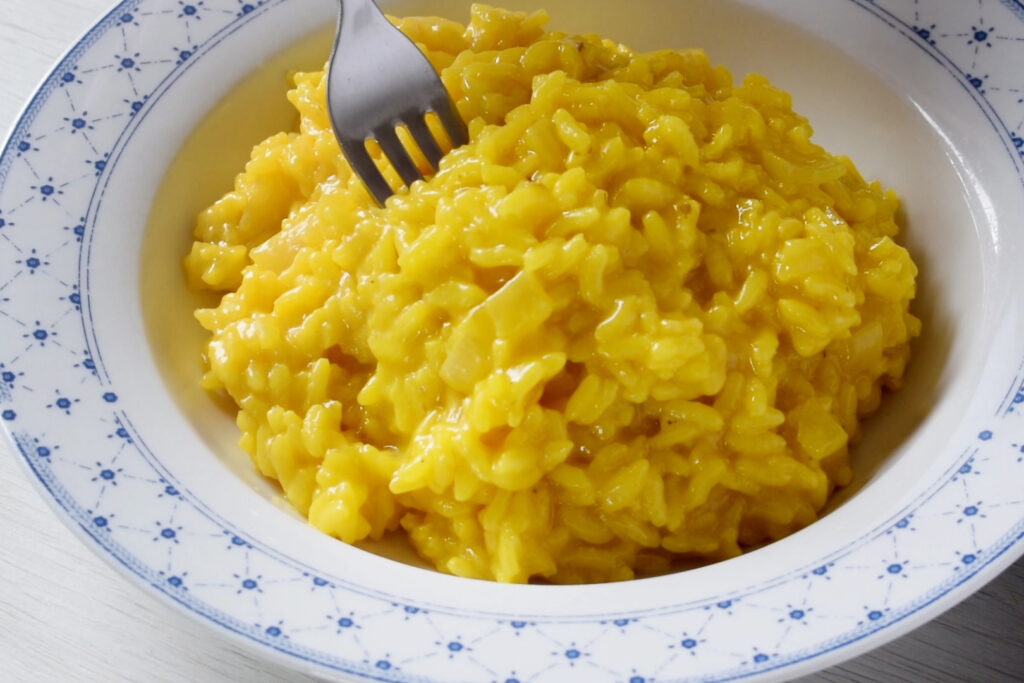
Serve the Milanese risotto hot!
How to Store Milanese Risotto?
To store Milanese Risotto, follow these guidelines to maintain its quality and freshness:
Cool Down Quickly: After cooking the risotto, cool it down as quickly as possible. Transfer the risotto to a shallow container or spread it out on a baking sheet to increase the surface area, allowing it to cool faster.
Refrigeration: Once the risotto has cooled, cover the container tightly with a lid or wrap it with plastic wrap. Place it in the refrigerator. Properly stored, Milanese risotto can typically be refrigerated for up to 3-4 days.
Avoid Freezing: Due to the high starch content, risotto tends to become mushy when frozen and thawed. It is generally not recommended to freeze Milanese risotto, as it may result in a less desirable texture.
Reheating: When you’re ready to enjoy the leftover risotto, reheat it gently to preserve its creamy texture. You can do this on the stovetop by adding a splash of broth or water to a pan, adding the refrigerated risotto, and stirring occasionally until heated through. Alternatively, with the leftover risotto, you can then prepare croquettes, arancini or “al Salto” rice (Jump Rice), i.e.sauté it in the pan giving it the shape of a flattened pie (a sort of omelette) on which a delicious crust forms which the most skilled know how to turn to cook the sides just making it jump.
Tips for Preparing Saffron Milanese Risotto
- Saffron pistils do not require soaking and can be inserted directly into dried risotto. However, care should be taken not to break them. Allowing them to soften slightly before mixing will help prevent breakage.
- Both butter and cheese should be added in a cold state in order to achieve a creamy and lustrous consistency.
- If needed, additional broth can be added after including chilled butter and grated cheese to adjust the texture of the risotto to the desired creaminess.
- For a lighter and more delicate flavor profile, the onion can be sautéed in extra virgin olive oil.
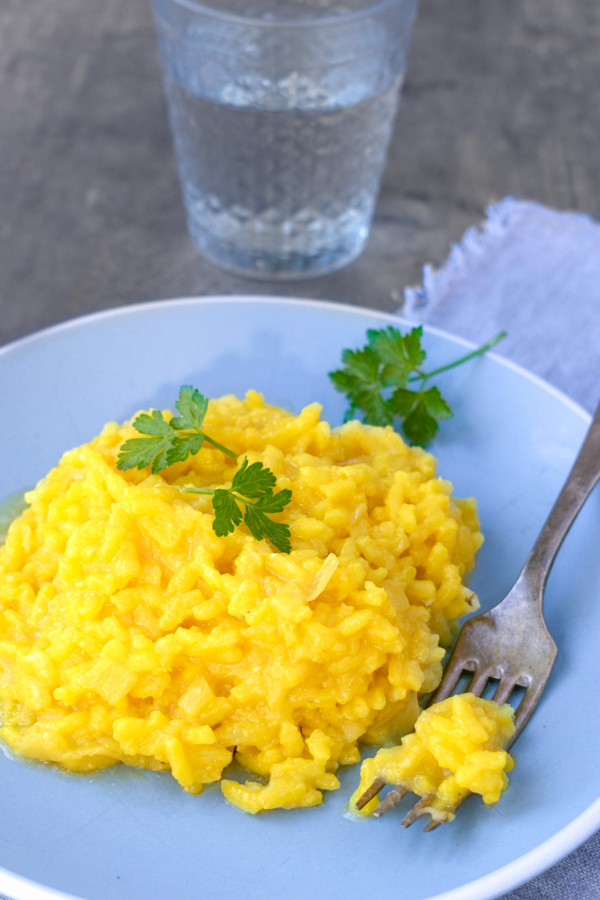

Saffron Risotto Milanese: The Irresistible Color and Unforgettable Taste
Ingredients
- 1 white onion
- 80 g butter
- 20 g beef bone marrow
- 320 g Carnaroli or Arborio rice
- 200 ml dry white wine
- 1.5 liter hot beef broth
- 2 powdered saffron sachets or 2 teaspoons of saffron pistils
- 70 g Parmesan cheese
- Salt to taste
Instructions
- First, peel and finely chop the onion.
- In a large skillet (where you will prepare the risotto), add 20 g of butter and bone marrow. Melt over medium heat, then add the onion and sauté for 1–2 minutes, until it begins to become translucent.
- Add the rice. Toast the rice for half a minute over medium-high heat while constantly stirring. This step will allow you to obtain an al dente risotto with intact grains!
- Add the white wine. Let it fully evaporate.
- Then lower the heat and begin adding the hot broth, one ladle at a time, stirring often and adding more broth each time the risotto is about to dry out! Be sure the broth is hot, otherwise everything will overcook.
- Finally, when the rice is al dente, add the saffron threads (or if using pistils, add the 2 teaspoons of orange-colored filtered water you soaked the pistils in the night before). Stir very well over low heat.
- Season with salt. At this stage, the risotto should not be liquid, but cooked and dry.
- Add the remaining butter and grated Parmesan, stir with a spoon over off heat so that the saffron Milanese risotto becomes creamy! Add only 1 or 2 teaspoons of hot broth if the rice seems too dry. The final risotto should be soft and creamy.
- Serve the Milanese risotto immediately!




